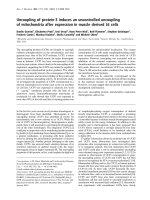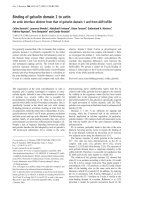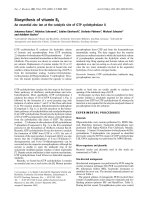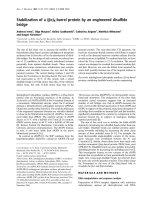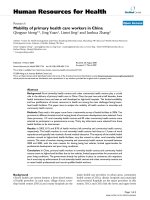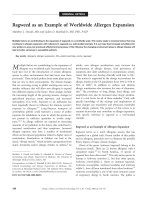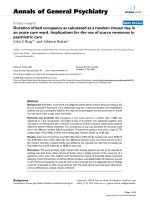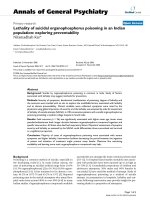Báo cáo y học: "Effectiveness of an evidence-based chiropractic continuing education workshop on participant knowledge of evidence-based health care" ppsx
Bạn đang xem bản rút gọn của tài liệu. Xem và tải ngay bản đầy đủ của tài liệu tại đây (275.19 KB, 8 trang )
BioMed Central
Page 1 of 8
(page number not for citation purposes)
Chiropractic & Osteopathy
Open Access
Research
Effectiveness of an evidence-based chiropractic continuing
education workshop on participant knowledge of evidence-based
health care
Ronald J Feise*
1
, Jaroslaw P Grod
2
and Anne Taylor-Vaisey
2
Address:
1
Institute of Evidence-Based Chiropractic, 6252 Rookery Road, Fort Collins, Colorado, USA and
2
Canadian Memorial Chiropractic
College, 6100 Leslie Street, Toronto, Ontario, Canada
Email: Ronald J Feise* - ; Jaroslaw P Grod - ; Anne Taylor-Vaisey -
* Corresponding author
Abstract
Background: Chiropractors must continue to learn, develop themselves professionally
throughout their careers, and become self-directed and lifelong learners. Using an evidence-based
approach increases the probability of optimal patient outcomes. But most chiropractors lack
knowledge and interest in evidence-based approaches. The purpose of this study was to develop
and measure the effectiveness of evidence-based training for chiropractic practitioners in a
continuing education setting.
Methods: We developed and evaluated a continuing education workshop on evidence-based
principles and methods for chiropractic practitioners. Forty-seven chiropractors participated in the
training and testing. The course consisted of 12.5 hours of training in which practitioners learned
to develop focused questions, search electronic data bases, critically review articles and apply
information from the literature to specific clinical questions. Following the workshop, we assessed
the program performance through the use of knowledge testing and anonymous presentation
quality surveys.
Results: Eighty-five percent of the participants completed all of the test, survey and data collection
items. Pretest knowledge scores (15-item test) were low (47%). Post intervention scores (15-item
test) improved with an effect size of 2.0. A 59-item knowledge posttest yielded very good results
(mean score 88%). The quality of presentation was rated very good, and most participants (90%)
would "definitely recommend" or "recommend" the workshop to a colleague.
Conclusion: The results of the study suggest that the continuing education course was effective
in enhancing knowledge in the evidence-based approach and that the presentation was well
accepted.
Background
Society assumes that all health care professionals will con-
tinue to learn and develop themselves professionally
throughout their lifetimes [1]. Practitioners spend numer-
ous hours each year in continuing education (CE) pro-
grams that ostensibly focus upon improving management
performance and/or optimizing patient outcomes [2]. CE
events are intended to bring health professionals up-to-
Published: 24 August 2006
Chiropractic & Osteopathy 2006, 14:18 doi:10.1186/1746-1340-14-18
Received: 30 May 2006
Accepted: 24 August 2006
This article is available from: />© 2006 Feise et al; licensee BioMed Central Ltd.
This is an Open Access article distributed under the terms of the Creative Commons Attribution License ( />),
which permits unrestricted use, distribution, and reproduction in any medium, provided the original work is properly cited.
Chiropractic & Osteopathy 2006, 14:18 />Page 2 of 8
(page number not for citation purposes)
date with rapidly expanding medical information. Moreo-
ver, CE educators have a duty to provide information that
has an affirmative impact on the health of patients (e.g.,
safe and effective).
Using an evidence-based approach increases the probabil-
ity of optimal patient outcomes by improving the health
care decision process [3,4]. Chiropractic has, for the most
part, relied on knowledge based on anecdote and tradi-
tion. Diagnostic and therapeutic intervention decisions
are often made with little to no attention to evidence-
based methods. Instruction in evidence-based methods
by chiropractic college clinics is almost absent [5]. How-
ever, a recent survey of current curricula of chiropractic
colleges found most colleges to be teaching evidence-
based concepts [6].
Chiropractors are ambivalent about the potential value of
the evidence-based approach in patient care. Some think
the approach is more academic than practical, and most
lack knowledge about evidence-based health care (EBHC)
[7,8]. The increasing trend towards health care provider
accountability demands that chiropractors have the essen-
tial competencies to perform effectively and efficiently in
a highly competitive health care system [9]. Because of the
exponential growth of information, practitioners must
acquire new skills to translate mountains of data into
improved patient results. Although a wide range of scien-
tific studies has been critically appraised in review articles,
practitioners still need a knowledge of EBHC principles
before they can properly apply the information from these
articles to patient management [10].
Reports about teaching the evidence-based approach in
the medical profession are fairly common [11-20]. Taylor
reviewed medical education studies and found evidence
that teaching critical appraisal skills improves both
knowledge and attitudes towards evidence-based decision
making [21]. Reviews by Davis found interactive medical
educational interventions to be generally effective in
changing practitioner behavior and even in improving
patient outcomes [2,22,23].
In contrast, published information on EBHC education in
the chiropractic field is rare. Five uncontrolled studies
reported improved critical appraisal skills and attitudes
towards an evidence-based approach among chiropractic
students [24-28]. However we found no published studies
of an educational intervention focusing upon teaching
EBHC methods to chiropractic practitioners. If chiroprac-
tors are to become effective evidence-based practitioners,
they need focused educational programs targeting specific
competencies. Acknowledging this need, we developed a
workshop for practitioners. This workshop teaches each of
the fundamental skills required for practicing evidence-
based health care.
Our objective was to develop and measure the effective-
ness of evidence-based training for chiropractic practition-
ers in a continuing education setting. Does an evidence-
based workshop result in improved knowledge of evi-
dence-based procedures? How do participants rate the
quality of the presentation?
Method
Overview
This study was an uncontrolled before-after design. We
developed an interactive evidence-based workshop for
chiropractic practitioners in a continuing education set-
ting. We then measured participants' knowledge of the
evidence-based approach with a fifteen-item pretest-post-
test and a 59-item post-intervention measure. We also col-
lected data regarding participant demographics and their
perception of the presentation.
Setting and sample
Participants were chiropractic practitioners enrolled in the
third year of a 300-hour 3-year Chiropractic Rehabilita-
tion Sciences program through the Canadian Memorial
Chiropractic College (CMCC). This educational interven-
tion was presented in Toronto and Calgary in 2005. Test-
ing, survey and demographic data were collected as a
routine matter during the workshop for quality improve-
ment purposes. The participants gave oral informed con-
sent to the collection of test, survey and demographic
data. They were assured of anonymity and confidentiality.
The Research and Ethics Board of the CMCC approved the
study protocol.
Outcome measures
The most widely used and popular model for the evalua-
tion of training and learning is Kirkpatrick's four-level
model [29].
The four levels of Kirkpatrick's evaluation model measure:
1. reactions of students – what they thought and felt about
the training;
2. learning – the resulting increase in knowledge or capa-
bility;
3. performance – extent of behavior and capability
improvement and implementation/application; and
4. impact – the effects on the business or environment
resulting from the trainee's performance.
Chiropractic & Osteopathy 2006, 14:18 />Page 3 of 8
(page number not for citation purposes)
We measured learning and participant perception of the
quality of the workshop presentation following Kirk-
patrick's model for evaluation of educational activities
[29]. The primary outcome measures were written tests of
EBHC knowledge. We assessed participant self-reported
workshop perception. We also collected basic demo-
graphic data in writing and asked what peer reviewed jour-
nals they regularly read. The phrase "regularly read" was
defined by each respondent.
Two measures were developed to test fundamental knowl-
edge of evidence-based methods: a 15-item pretest-post-
test measure and a 59-item comprehensive post -
intervention measure. The 15-item measure established a
baseline for participants' knowledge and aided in moti-
vating participants during the training. The 15-item meas-
ure was also nested in the 59-item comprehensive post-
intervention measure.
The knowledge measure questions were developed from a
pool of 86 items linked to the application of EBHC [30-
35]. Considering the practical application of EBHC to chi-
ropractic practitioners, two chiropractic researchers with
clinical experience reduced the pool to 59 items for a com-
prehensive post-intervention test, and 15 of those items
were used for the pretest-posttest using a modified Delphi
Method. The knowledge measures were tested for reada-
bility and comprehensibility in previous workshops. The
suggestions of test participants were incorporated to
improve the measures' readability and meaningfulness.
Content for the knowledge measures paralleled course
objectives. The measures employed multiple choice,
dichotomized response and free text responses (15-item
measure: 14 free text and 1 dichotomized response; 59-
item measure: 15 multiple choice, 30 dichotomized
responses, 14 free text responses).
For grading purposes, 1 point was allotted per correctly
answered question item (partial credit was given for some
question items that required multiple responses). Scores
were created by converting raw scores to a 0–100 measure-
ment scale by summing the correct items, dividing by the
maximum possible total score and multiplying by 100.
Participants were given 60 minutes to complete the com-
prehensive measure; they were given 10 minutes for the
15-item pretest. Participants were not allowed to refer to
materials. Exams were self-graded and submitted anony-
mously. A random sample of tests was examined, and no
discrepancies were found between the self-reported scores
and instructor scores.
We used four items to measure participants' perception of
the presentation (overall evaluation, recommendation of
this workshop, knowledge of the presenter and knowl-
edge gained). The response scale for each item was a 5-
point scale (e.g., excellent, very good, good, fair, poor).
Additionally, we asked participants if the workshop met
their learning objectives with a dichotomized scale and
allowed for free text comments.
Educational intervention
We used adult learning theory principles in designing the
context of this workshop: the establishment of a need to
comprehend, self-direction, task-centered approach,
opportunity to receive and offer feedback and attention to
the importance of real-life conditions [12,36,37]. We were
influenced by continuing education methods that have
been shown to have a reasonable chance of influencing
behavior in practice: we limited didactic lecture, engaged
participants (non-threatening atmosphere), posed pro-
vocative questions, acknowledged limitations, applied
adult retention schemes for key points and kindled inter-
action among participants [22]. The instructor, a chiro-
practic practitioner for 20 years, has been involved in
teaching EBHC for almost a decade and is an active
researcher and peer reviewer for medical and chiropractic
journals.
The aim of the workshop was to develop competency in
evidence-based principles and procedures. The overriding
goal was for participants to attain the skills to properly
integrate scientific evidence by learning the following
competencies: (1) articulate clinically important ques-
tions; (2) locate and access relevant literature to address
the questions; (3) critically appraise the literature for its
usefulness and validity; and, (4) utilize the results of
assessments to improve patient management [32]. We
provided all participants with a 110-page workbook and
conducted a 12.5 hour training over a two day period.
Group discussion was encouraged, and participants com-
pleted worksheets and answered questions within each
section to review key concepts. The most critical part of
the workshop was interpretation of study results for
enhanced patient management.
Data collection and statistical analysis
We calculated descriptive statistics: percentages, mean,
standard deviation and range, as appropriate. For compar-
ative analysis, effect size was estimated [effect size = delta
(mean change)/sigma (the standard deviation at base-
line]. This study used Cohen's d for dependent means
effect size method [38]. The following standards were
used to interpret effect size data: small size effect (.2);
medium size effect (.5); and large size effect (≥ .8) [39]. A
positive score indicates knowledge gain, and a negative
score indicates knowledge deterioration. Pearson's prod-
uct moment correlation coefficient was used to test the
correlation between knowledge scores and participants'
ages and years in practice. All data were entered into a data
base and analyzed with Minitab 10.51 Xtra (State College,
Chiropractic & Osteopathy 2006, 14:18 />Page 4 of 8
(page number not for citation purposes)
Pennsylvania). All the data were randomly checked for
accuracy.
Results
Participants' characteristics
Baseline characteristics of the participants are presented in
Table 1. Forty-seven practitioners attended the workshop,
and forty provided data for this study (response rate was
85%). The respondents were mostly male (76%) gradu-
ates of CMCC (58%) with a mean age of 36 years, approx-
imately 9 years of clinical experience, and most were in
solo practice (65%). Eighty-eight percent were enrolled in
the Chiropractic Rehabilitation Sciences program at
CMCC, and 68% read no peer reviewed journals on a reg-
ular basis. In comparison, a random national survey of
Canadian chiropractors found that most were male (81%)
graduates of CMCC (73%) with a mean age of 40 years
and approximately 13 years of clinical experience [40].
Knowledge measures
The mean baseline score for the 15-item pretest was 7.1
(47%) correct responses (min. and max. 2 – 13, SD 2.7).
After 11 hours of teaching (over a two-day period), we
retested the same participants by nesting the original 15-
item test (posttest) into our final exam of 59 questions.
The mean score for the posttest was 12.5 (83%) correct
responses (min. and max. 8 – 15, SD 1.8). The effect size
was 2.0. The mean score for the final exam (59 questions)
was 52.1 (88%) correct responses (min. and max. 43 – 59,
SD 3.4). Pearson's coefficient produced the following cor-
relations: years in practice correlated very weakly and
inversely with pretest score ( 18; P = .37); participant age
correlated weakly and inversely with pretest scores ( 34; P
= .09). Correlations between years in practice or partici-
pant age and post workshop test scores were less than .10
(P > .65).
Quality of presentation
Participant perception data is provided in Figures 1, 2, 3.
Ninety percent of the participants rated the workshop
overall as "excellent" or "very good" and would "defi-
nitely recommend" or "recommend" the workshop to a
colleague. All of the participants reported that the work-
shop met their learning objectives and that the presenter
was "very knowledgeable" or "above average" in knowl-
edge. Ninety-three percent reported that they learned "a
great deal" or "a good amount" of knowledge. Ten partic-
ipants provided free text comments that were mostly very
positive (Table 2).
Discussion
Evidence-based practitioners are the future leaders of chi-
ropractic, because they possess the ability to apply
research and are likely to deliver more effective and less
costly interventions. The abilities to assess data critically,
evaluate study methods, and evaluate study outcomes are
essential cognitive competencies used by successful health
care practitioners in caring for their patients in this era of
accountability and continual quality improvement. Like
most cognitive skills, EBHC principles need to be rein-
Table 1: Participant characteristics at baseline (n = 40)
Characteristic
Male, % (n) 76% (31)
Age, mean 36.3 (SD 6.0, min to max 30 – 53)
Years in practice, mean 8.5 (SD 6.5, min to max 2 – 28)
Chiropractic College, % (n)
CMCC 58% (23)
Palmer 13% (5)
National 10% (4)
Logan 8% (3)
Palmer-West, LACC, New York, Parker 1 participant each
Postgraduate certification, % (n)
in progress 88% (35)
yes 10% (4)
no 2% (1)
Solo practice, % (n) 65% (26)
Peer Reviewed Journals (read regularly), % (n)*
none 68% (27)
JMPT 15% (6)
JCCA 15% (6)
Spine 5% (2)
NEJM 2% (1)
Cochrane 2% (1)
J Sports Chiro & Rehab 2% (1)
* Participants could select more than one journal.
Chiropractic & Osteopathy 2006, 14:18 />Page 5 of 8
(page number not for citation purposes)
forced through application and repetition [15]. Noted
experts have straightforwardly stated that chiropractic
practitioners using the EBHC approach benefit from being
able to:
1. Be more effective and efficient.
2. Deal with expanded demands for accountability.
3. Manage rapidly expanding sources of information.
4. Maintain professional competence.
5. Provide an increased quality of care [41].
The results of this study suggest that our educational inter-
vention enhanced practitioners' EBHC knowledge. Work-
shop participants reported high scores for the quality of
the workshop presentation.
The response rate to the surveys and tests was good. Over-
all, these participants might be considered more inter-
ested in research evidence and peer reviewed journals
than the average chiropractor. However, more than two-
thirds of the participants read no peer reviewed journals
on a regular basis. This is not unexpected, because sub-
scription rates to peer reviewed journals are low within
the profession.
As expected, participants scored poorly before the work-
shop intervention and performed exceedingly well in post
intervention testing. For the 15-item pre-posttest, the
effect size was very large. A mean score of 88% on the 59-
item test is considered noteworthy. We compared baseline
knowledge scores with participants' ages and found a
weak inverse relationship. Also, we compared baseline
knowledge scores with participants' years in practice and
found a very weak inverse relationship. These findings are
not discordant with indecisive findings from a systematic
review that reported that medical physicians who have
been in practice longer may be at risk for providing lower-
quality care and posses less up-to-date knowledge [42].
Posttest scores measuring knowledge gain likewise were
not related to participant age or years in practice (i.e.,
older participants grasped the EBHC concepts just as well
as the younger participants).
Table 2: Participant comments (n = 10)
#1. "Excellent! You kept the audience engaged throughout!"
#2. "Fabulous."
#3. "Great presentation. Perhaps add PowerPoint?"
#4. "Made a boring subject interesting."
#5. "Did an excellent job on a very dry topic!"
#6. "Extremely helpful."
#7. "It has changed my ability."
#8. "Engaging. Made a very dry subject enjoyable. Thanks."
#9. "Excellent way to engage adult learners."
#10. "Too much information, very long. Good information. Give information before hand. No reason for people to read any notes out loud."
What is your overall evaluation of this workshop (n = 40)?Figure 1
What is your overall evaluation of this workshop (n = 40)?.
50%
40%
10%
0%
10%
20%
30%
40%
50%
Excellent Very Good Good Fair Poor
Chiropractic & Osteopathy 2006, 14:18 />Page 6 of 8
(page number not for citation purposes)
The quality of the presentation is an important variable in
the education process. In this study, participants rated the
quality of presentation very high. Free text comments pri-
marily indicated appreciation of the preparation and
implementation of the workshop. Because of the ano-
nymity with which data were collected, participants were
likely to be honest in their feedback. It is difficult to imag-
ine a poor quality presentation yielding respectable
knowledge gains, improving practitioner behavior or
improving patient outcomes [2,29]. Thus, participant per-
ception of the presentation's quality is an important ele-
ment in educational courses.
Our workshop's effectiveness, we believe, derives largely
from its fidelity to adult learning theory and implementa-
tion of effective health care CE strategies. Educational
interventions involving active participant involvement
lead to "deeper processing of information" and, conse-
quently, improved recollection of factual information
[43]. Interactive educational meetings (participation of
Would you recommend this workshop to a colleague (n = 40)?Figure 2
Would you recommend this workshop to a colleague (n = 40)?.
60%
30%
7%
3%
0%
10%
20%
30%
40%
50%
60%
Definitely
would
Would Not sure Would not Definitely
would not
How much knowledge did you gain from this workshop (n = 40)?Figure 3
How much knowledge did you gain from this workshop (n = 40)?.
50% 43%
7%
0%
10%
20%
30%
40%
50%
A great deal A good amount Some A little Nothing
Chiropractic & Osteopathy 2006, 14:18 />Page 7 of 8
(page number not for citation purposes)
healthcare providers in workshops that include discussion
and/or practice) are generally effective [2,44]. Passive dis-
semination of information (e.g., chiefly didactic lecture)
is generally ineffective.
Limitations
The research design used for this study limits inferences
that should be drawn from the study's conclusions. This
study is a before-after design without controls and is not
as strong as a randomized trial. Participants were self-
selected, and were possibly more motivated and more
likely to benefit from the intervention than the general
population of chiropractors.
Our study may also be criticized for reporting on process
measures (knowledge gained, quality of presentation),
rather than practitioner behavior and clinical outcomes.
The long-term goal of continuing education is not merely
to impart new knowledge, but rather to change learners'
behaviors [45]. However, patient outcomes are difficult to
measure and are affected by many other unrelated varia-
bles [45]. Measures farther away from the intervention can
easily be influenced by un-measurable untoward events
compared with the more proximal and easier-to-measure
items of competence: knowledge, skills and attitudes.
Ideal outcomes would include estimates of a continuum
of measures: competence to performance to health care
outcomes [2]. Also, our evaluation was short-term, so we
cannot assess the durability of the knowledge.
Measurement bias might have occurred, because our test
to measure EBHC knowledge had not been previously
assessed. However, the impressive improvement between
pre- and post-testing scores provides support for the
instrument's psychometric qualities. The educational lit-
erature recognizes that pre-assessment may lead to a
higher post-assessment score due to an item-practice
effect [46]. There is a possibility of a test-training effect,
because we used an identical posttest; that is, it is possible
that participants learned how to take the same test better
the second time around, rather than really learning new
knowledge. However, participants' scores for the 59-item
test were high. It is unlikely that participants inflated their
test scores, because they submitted their scores anony-
mously, and we found no differences between self-
reported scoring and instructor scoring.
Future studies should incorporate more rigorous design,
including validation of outcome measures, larger sample
size, use of a control group, and follow-up. Ideally,
upcoming studies should measure the effect of the inter-
vention on patient outcomes, preferably in randomized
controlled trials. It is difficult to predict the generalisabil-
ity of our findings; it is unknown whether other instruc-
tors with different content and context would achieve
similar improvements [47,48]. Despite these limitations,
our evaluation demonstrated a positive impact on the par-
ticipants' EBHC knowledge and a high perception of the
workshop presentation's quality.
Conclusion
The results of the study imply that the intervention was
effective in enhancing EBHC knowledge. The effect size
was large. Because there were several potential sources of
variation, further study is required. The quality of presen-
tation was graded very highly. Thus, this workshop may
provide a model by which EBHC knowledge can be taught
to practitioners.
Competing interests
The author(s) declare that they have no competing inter-
ests.
Authors' contributions
RJF conceived of the study and participated in its design.
He also acquired data, analyzed and interpreted data and
helped to draft the manuscript. JPG participated in study
coordination and interpretation of data and helped to
draft the manuscript. ATV participated in study design and
was involved in revising the manuscript. All authors read
and approved the final manuscript.
References
1. Mann KV: Reflecting on the challenges facing continuing med-
ical education today. Med Educ 2005, 39:546-547.
2. Davis DA, O'Brien MA, Freemantle N, Wolf FM, Mazmanian P, Tay-
lor-Vaisey A: Impact of formal continuing medical education:
do conferences, workshops, rounds, and other traditional
continuing education activities change physician behavior or
health care outcomes? JAMA 1999, 282:867-874.
3. Holloway R, Nesbit K, Bordley D, Noyes K: Teaching and evalu-
ating first and second year medical students' practice of evi-
dence-based medicine. Med Educ 2004, 38:868-878.
4. Weberschock TB, Ginn TC, Reinhold J, Strametz R, Krug D, Bergold
M, Schulze J: Change in knowledge and skills of Year 3 under-
graduates in evidence-based medicine seminars. Med Educ
2005, 39:665-671.
5. Rose KA, Adams A: A survey of the use of evidence-based
health care in chiropractic college clinics. J Chiro Educ 2000,
14:71-77.
6. Feise RJ: Cross-sectional study of evidence-based health care
instruction in chiropractic college curricula [unpublished
survey]. 2006.
7. Meeker WC: Concepts germane to an evidence-based appli-
cation of chiropractic theory. Top Clin Chiro 2000, 7:67-73.
8. Feise RJ: An inquiry into chiropractors' intention to treat ado-
lescent idiopathic scoliosis: a telephone survey. J Manipulative
Physiol Ther 2001, 24:177-182.
9. Smith M, Long C, Henderson C, Marchiori DM: Report on an inno-
vative strategy for teaching evidence-based skills to chiro-
practic students [conference abstract]. Proceedings of the 2001
World Federation of Chiropractic Congress 2001, 6:399-400.
10. Guyatt GH, Meade MO, Jaeschke RZ, Cook DJ, Haynes RB: Practi-
tioners of evidence based care. Not all clinicians need to
appraise evidence from scratch but all need some skills. BMJ
2000, 320:954-955.
11. Linzer M, Brown JT, Frazier LM, DeLong ER, Siegel WC: Impact of
a medical journal club on house-staff reading habits, knowl-
edge, and critical appraisal skills. A randomized control trial.
JAMA 1988, 260:2537-2541.
Publish with BioMed Central and every
scientist can read your work free of charge
"BioMed Central will be the most significant development for
disseminating the results of biomedical research in our lifetime."
Sir Paul Nurse, Cancer Research UK
Your research papers will be:
available free of charge to the entire biomedical community
peer reviewed and published immediately upon acceptance
cited in PubMed and archived on PubMed Central
yours — you keep the copyright
Submit your manuscript here:
/>BioMedcentral
Chiropractic & Osteopathy 2006, 14:18 />Page 8 of 8
(page number not for citation purposes)
12. Green ML, Ellis PJ: Impact of an evidence-based medicine cur-
riculum based on adult learning theory. J Gen Intern Med 1997,
12:742-750.
13. Seelig CB: Affecting residents' literature reading attitudes,
behaviors, and knowledge through a journal club interven-
tion. J Gen Intern Med 1991, 6:330-334.
14. Kitchens JM, Pfeifer MP: Teaching residents to read the medical
literature: a controlled trial of a curriculum in critical
appraisal/clinical epidemiology. J Gen Intern Med 1989,
4:384-387.
15. Srinivasan M, Weiner M, Breitfeld PP, Brahmi F, Dickerson KL,
Weiner G: Early introduction of an evidence-based medicine
course to preclinical medical students. J Gen Intern Med 2002,
17:58-65.
16. Goldberg HI, Deyo RA, Taylor VM, Cheadle AD, Conrad DA, Loeser
JD, Heagerty PJ, Diehr P: Can evidence change the rate of back
surgery? A randomized trial of community-based education.
Eff Clin Pract 2001, 4:95-104.
17. Balas EA, Boren SA, Hicks LL, Chonko AM, Stephenson K: Effect of
linking practice data to published evidence. A randomized
controlled trial of clinical direct reports. Med Care 1998,
36:79-87.
18. Sanci LA, Coffey CM, Veit FC, Carr-Gregg M, Patton GC, Day N,
Bowes G: Evaluation of the effectiveness of an educational
intervention for general practitioners in adolescent health
care: randomised controlled trial. BMJ 2000, 320:224-230.
19. Bernal-Delgado E, Galeote-Mayor M, Pradas-Arnal F, Peiro-Moreno
S: Evidence based educational outreach visits: effects on pre-
scriptions of non-steroidal anti-inflammatory drugs. J Epide-
miol Community Health 2002, 56:653-658.
20. D'Onofrio G, Nadel ES, Degutis LC, Sullivan LM, Casper K, Bernstein
E, Samet JH: Improving emergency medicine residents'
approach to patients with alcohol problems: a controlled
educational trial. Ann Emerg Med 2002, 40:50-62.
21. Taylor R, Reeves B, Ewings P, Binns S, Keast J, Mears R: A system-
atic review of the effectiveness of critical appraisal skills
training for clinicians.
Med Educ 2000, 34:120-125.
22. Davis DA, Thomson MA, Oxman AD, Haynes RB: Evidence for the
effectiveness of CME. A review of 50 randomized controlled
trials. JAMA 1992, 268:1111-1117.
23. O'Brien T, Freemantle N, Oxman AD, Wolf F, Davis DA, Herrin J:
Continuing education meetings and workshops: effects on
professional practice and health care outcomes (Cochrane
Review). Cochrane Database Syst Rev 2001,
2:CD003030.:CD003030.
24. Green B, Johnson C: Teaching clinical epidemiology in chiro-
practic: a first-year course in evidence-based healthcare. J
Chiro Educ 1999, 13:18-19.
25. Green B: Letters to the editor for teaching critical thinking
and professional communication. J Chiro Educ 2001, 15:18-19.
26. Smith M, Long C, Henderson C, Marchiori DM, Hawk C, Meeker
WC, Killinger LZ: Report on the development, implementa-
tion, and evaluation of an evidence-based skills course: a les-
son in incremental curricular change. J Chiro Educ 2004,
18:116-126.
27. Fernandez CE, Delaney PM: Applying evidence-based health
care to musculoskeletal patients as an educational strategy
for chiropractic interns (a one-group pretest-posttest
study). J Manipulative Physiol Ther 2004, 27:253-261.
28. Jamison JR: Fostering critical thinking skills: A strategy for
enhancing evidence based wellness care. Chiropr Osteopat 2005,
13:19.
29. Kirkpatrick DL: Evaluating Training Programs: The Four Levels San Fran-
cisco CA, Berrett-Koehler; 1994.
30. Fletcher RH, Fletcher SW, Wagner EH: Clinical Epidemiology: the Essen-
tials 3rd edition. Baltimore MD, Williams & Wilkins; 1996.
31. Gehlback SH: Interpreting the Medical Literature New York, McGraw-
Hill; 1993.
32. Sackett DL, Straus SE, Richardson WS, Rosenberg WM, Haynes RB:
Evidence-Based Medicine: How to Practice and Teach EBM [2d ed] Edin-
burgh, Churchill Livingstone; 2000.
33. Hagino C: How to Appraise Research: a Guide for Chiropractic Students
and Practitioners
London, Churchill Livingstone; 2003.
34. Greenberg RS, Daniels SR, Flanders WD, Eley JW, Boring JR: Medical
Epidemiology New York, Lange; 2001.
35. Riegelman RK, Hirsch RP: Studying a Study and Testing a Test: How to
Read the Health Science Literature New York, Little, Brown & Com-
pany; 1996.
36. Knowles M: The Adult Learner: a Neglected Species Houston TX, Gulf
Publishing; 1984.
37. Barrows HS: Problem-based, self-directed learning. JAMA 1983,
250:3077-3080.
38. Cohen J: Statistical Power Analysis for the Behavioral Sciences 2nd edition.
Hillsdale NJ, Lawrence Earlbaum Associates; 1988.
39. Cohen J: Statistical Power Analysis for the Behavioral Sciences New York,
Academic Press; 1977.
40. Verhoef MJ, Papadopoulos C: Survey of Canadian chiropractors'
involvement in the treatment of patients under the age of
18. J Can Chiro Assoc 1999, 43:50-57.
41. Delaney PM, Fernandez CE: Toward an evidence-based model
for chiropractic education and practice. J Manipulative Physiol
Ther 1999, 22:114-118.
42. Choudry NK, Fletcher RH, Soumerai SB: Systematic review: the
relationship between clinical experience and quality of
health care. Ann Intern Med 2005, 142:260-273.
43. Onion CW, Bartzokas CA: Changing attitudes to infection man-
agement in primary care: a controlled trial of active versus
passive guideline implementation strategies. Fam Pract 1998,
15:99-104.
44. Bero LA, Grilli R, Grimshaw JM, Harvey E, Oxman AD, Thomson MA:
Closing the gap between research and practice: an overview
of systematic reviews of interventions to promote the imple-
mentation of research findings. The Cochrane Effective
Practice and Organization of Care Review Group. BMJ 1998,
317:465-468.
45. Hatala R, Guyatt G: Evaluating the teaching of evidence-based
medicine. JAMA 2002, 288:1110-1112.
46. Welch WW, Walberg HJ: Pretest and sensitisation effects in
curriculum evaluation. Am Educ Res J 1970, 7:605-614.
47. Hutchinson L: Evaluating and researching the effectiveness of
educational interventions.
BMJ 1999, 318:1267-1269.
48. Campbell M, Fitzpatrick R, Haines A, Kinmonth AL, Sandercock P,
Spiegelhalter D, Tyrer P: Framework for design and evaluation
of complex interventions to improve health. BMJ 2000,
321:694-696.

